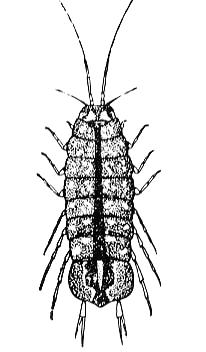Woodlouse or Waterlouse?
by Mike Morgan
 If you
look under a stone in the garden, it is very likely you will find
a woodlouse. These are one of the few Crustacea which are land
animals. They have relatives which may be found at the seashore
or in freshwater. The waterlouse is very common in freshwater,
i.e. ponds or slow-moving streams.
If you
look under a stone in the garden, it is very likely you will find
a woodlouse. These are one of the few Crustacea which are land
animals. They have relatives which may be found at the seashore
or in freshwater. The waterlouse is very common in freshwater,
i.e. ponds or slow-moving streams.
A waterlouse (Asellus) is shown on the
right , and in appearance looks just like an ordinary woodlouse.
There are characteristics which help to distinguish the two. If
you look at a waterlouse, having placed it on its back, note how
the body is flat compared with its depth. Also compare the legs
and antennae . These are much longer than seen in the wood-louse.
Asellus lives very well in an aquarium
among water-weed. This is an ideal specimen to keep, to
demonstrate crustacean characters. They breed readily, the
females laying their eggs about April or May.
If the females carrying eggs or young are
isolated in a petri dish, these can be observed until the young
are set free. These are interesting in that there is no pigment
in the skin. This makes the young one of the best specimens to
observe the circulation of blood in the Crustacea. Individual
corpuscles can be seen circulating and the contractions of the
heart can be watched, before the development of pigment in the
skin of the adult.
This is a lovely experiment for interested kids
to do. Similar to watching the heartbeat and circulation in
Daphnia.
Editor's Note: This article by Ron Neumeyer also shows a woodlouse.
© Microscopy UK or their
contributors.
Please report any Web problems
or offer comments to the Micscape Editor,
via the contact on current Micscape Index.
Micscape is the on-line monthly
magazine of the Microscopy UK web
site at Microscopy-UK
WIDTH=1
© Onview.net Ltd, Microscopy-UK, and all contributors 1995 onwards. All rights
reserved. Main site is at www.microscopy-uk.org.uk with full mirror at www.microscopy-uk.net.
 If you
look under a stone in the garden, it is very likely you will find
a woodlouse. These are one of the few Crustacea which are land
animals. They have relatives which may be found at the seashore
or in freshwater. The waterlouse is very common in freshwater,
i.e. ponds or slow-moving streams.
If you
look under a stone in the garden, it is very likely you will find
a woodlouse. These are one of the few Crustacea which are land
animals. They have relatives which may be found at the seashore
or in freshwater. The waterlouse is very common in freshwater,
i.e. ponds or slow-moving streams.